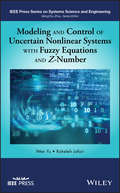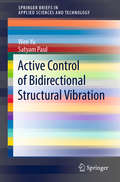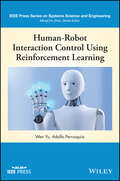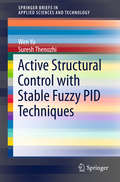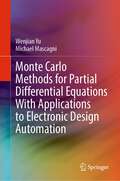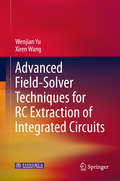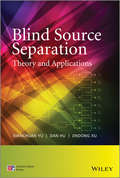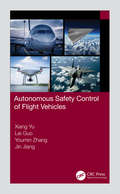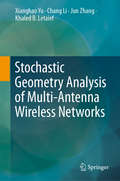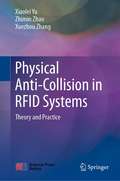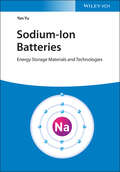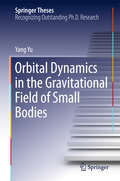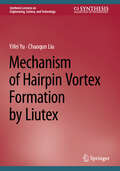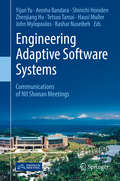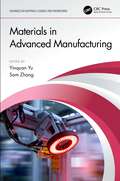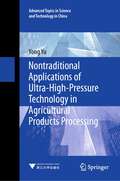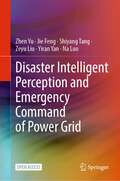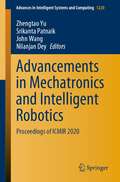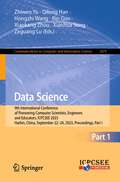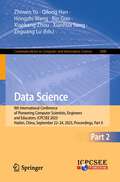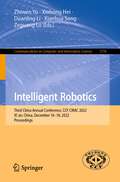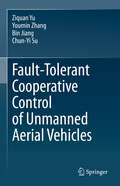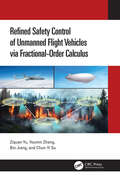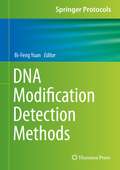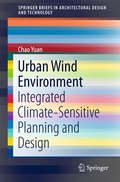- Table View
- List View
Modeling and Control of Uncertain Nonlinear Systems with Fuzzy Equations and Z-Number (IEEE Press Series on Systems Science and Engineering)
by Wen Yu Raheleh JafariThere are various numerical and analytical approaches to the modeling and control of uncertain nonlinear systems. Fuzzy logic theory is an increasingly popular method used to solve inconvenience problems in nonlinear modeling. Modeling and Control of Uncertain Nonlinear Systems with Fuzzy Equations and Z-Number presents a structured approach to the control and modeling of uncertain nonlinear systems in industry using fuzzy equations and fuzzy differential equations. <p><p> The first major work to explore methods based on neural networks and Bernstein neural networks, this innovative volume provides a framework for control and modeling of uncertain nonlinear systems with applications to industry. Readers learn how to use fuzzy techniques to solve scientific and engineering problems and understand intelligent control design and applications. The text assembles the results of four years of research on control of uncertain nonlinear systems with dual fuzzy equations, fuzzy modeling for uncertain nonlinear systems with fuzzy equations, the numerical solution of fuzzy equations with Z-numbers, and the numerical solution of fuzzy differential equations with Z-numbers. <p> Modeling and Control of Uncertain Nonlinear Systems with Fuzzy Equations and Z-Number is suitable as a textbook for advanced students, academic and industrial researchers, and practitioners in fields of systems engineering, learning control systems, neural networks, computational intelligence, and fuzzy logic control.
Active Control of Bidirectional Structural Vibration (SpringerBriefs in Applied Sciences and Technology)
by Wen Yu Satyam PaulThis book focuses on safeguarding civil structures and residents from natural hazards such as earthquakes through the use of active control. It proposes novel proportional-derivative (PD) and proportional-integral-derivative (PID) controllers, as well as discrete-time sliding mode controllers (DSMCs) for the vibration control of structures involving nonlinearities. Fuzzy logic techniques are used to compensate for nonlinearities. The first part of the book addresses modelling and feedback control in inelastic structures and presents a design for PD/PID controllers. In the second part, classical PD/PID and type-2 fuzzy control techniques are combined to compensate for uncertainties in the structures of buildings. The methodology for tuning the gains of PD/PID is obtained using Lyapunov stability theory, and the system’s stability is verified. Lastly, the book puts forward a DSMC design that does not require system parameters, allowing it to be more flexibly applied. All program codes used in the paper are presented in a MATLAB®/Simulink® environment. Given its scope, the book will be of interest to mechanical and civil engineers, and to advanced undergraduate and graduate engineering students in the areas of structural engineering, structural vibration, and advanced control.
Human-Robot Interaction Control Using Reinforcement Learning (IEEE Press Series on Systems Science and Engineering)
by Wen Yu Adolfo PerrusquiaA comprehensive exploration of the control schemes of human-robot interactions In Human-Robot Interaction Control Using Reinforcement Learning, an expert team of authors delivers a concise overview of human-robot interaction control schemes and insightful presentations of novel, model-free and reinforcement learning controllers. The book begins with a brief introduction to state-of-the-art human-robot interaction control and reinforcement learning before moving on to describe the typical environment model. The authors also describe some of the most famous identification techniques for parameter estimation. Human-Robot Interaction Control Using Reinforcement Learning offers rigorous mathematical treatments and demonstrations that facilitate the understanding of control schemes and algorithms. It also describes stability and convergence analysis of human-robot interaction control and reinforcement learning based control. The authors also discuss advanced and cutting-edge topics, like inverse and velocity kinematics solutions, H2 neural control, and likely upcoming developments in the field of robotics. Readers will also enjoy: A thorough introduction to model-based human-robot interaction control Comprehensive explorations of model-free human-robot interaction control and human-in-the-loop control using Euler angles Practical discussions of reinforcement learning for robot position and force control, as well as continuous time reinforcement learning for robot force control In-depth examinations of robot control in worst-case uncertainty using reinforcement learning and the control of redundant robots using multi-agent reinforcement learning Perfect for senior undergraduate and graduate students, academic researchers, and industrial practitioners studying and working in the fields of robotics, learning control systems, neural networks, and computational intelligence, Human-Robot Interaction Control Using Reinforcement Learning is also an indispensable resource for students and professionals studying reinforcement learning.
Active Structural Control with Stable Fuzzy PID Techniques (SpringerBriefs in Applied Sciences and Technology)
by Wen Yu Suresh ThenozhiThis book presents a detailed discussion of intelligenttechniques to measure the displacement of buildings when they are subjected tovibration. It shows how these techniques are used to control active devicesthat can reduce vibration 60-80% more effectively than widely used passiveanti-seismic systems. After introducing various structural control devices andbuilding-modeling and active structural control methods, the authors proposeoffset cancellation and high-pass filtering techniques to solve some commonproblems of building-displacement measurement using accelerometers. The mostpopular control algorithms in industrial settings, PD/PID controllers, are thenanalyzed and then combined with fuzzy compensation. The stability of thiscombination is proven with standard weight-training algorithms. These conditionsprovide explicit methods for selecting PD/PID controllers. Finally, fuzzy-logicand sliding-mode control are applied to the control of wind-induced vibration. The methods described are supported by reports of experimental studies on atwo-story building prototype. This book is avaluable resource for academic researchers interested in the effects of controland mechatronic devices within buildings, or those studying the principles ofvibration reduction. Practicing engineers working on the design andconstruction of any sort of high-rise or vulnerable building and concerned withthe effects of either wind or seismic disturbances benefit from the efficacy ofthe methods proposed.
Monte Carlo Methods for Partial Differential Equations With Applications to Electronic Design Automation
by Wenjian Yu Michael MascagniThe Monte Carlo method is one of the top 10 algorithms in the 20th century. This book is focusing on the Monte Carlo method for solving deterministic partial differential equations (PDEs), especially its application to electronic design automation (EDA) problems. Compared with the traditional method, the Monte Carlo method is more efficient when point values or linear functional of the solution are needed, and has the advantages on scalability, parallelism, and stability of accuracy. This book presents a systematic introduction to the Monte Carlo method for solving major kinds of PDEs, and the detailed explanation of relevant techniques for EDA problems especially the cutting-edge algorithms of random walk based capacitance extraction. It includes about 100 figures and 50 tables, and brings the reader a close look to the newest research results and the sophisticated algorithmic skills in Monte Carlo simulation software.
Advanced Field-Solver Techniques for RC Extraction of Integrated Circuits
by Wenjian Yu Xiren WangResistance and capacitance (RC) extraction is an essential step in modeling the interconnection wires and substrate coupling effect in nanometer-technology integrated circuits (IC). The field-solver techniques for RC extraction guarantee the accuracy of modeling, and are becoming increasingly important in meeting the demand for accurate modeling and simulation of VLSI designs. Advanced Field-Solver Techniques for RC Extraction of Integrated Circuits presents a systematic introduction to, and treatment of, the key field-solver methods for RC extraction of VLSI interconnects and substrate coupling in mixed-signal ICs. Various field-solver techniques are explained in detail, with real-world examples to illustrate the advantages and disadvantages of each algorithm. This book will benefit graduate students and researchers in the field of electrical and computer engineering as well as engineers working in the IC design and design automation industries. Dr. Wenjian Yu is an Associate Professor at the Department of Computer Science and Technology at Tsinghua University in China; Dr. Xiren Wang is a R&D Engineer at Cadence Design Systems in the USA.
Blind Source Separation: Theory and Applications
by Xianchuan Yu Dan Hu Jindong XuA systematic exploration of both classic and contemporary algorithms in blind source separation with practical case studies The book presents an overview of Blind Source Separation, a relatively new signal processing method. Due to the multidisciplinary nature of the subject, the book has been written so as to appeal to an audience from very different backgrounds. Basic mathematical skills (e.g. on matrix algebra and foundations of probability theory) are essential in order to understand the algorithms, although the book is written in an introductory, accessible style. This book offers a general overview of the basics of Blind Source Separation, important solutions and algorithms, and in-depth coverage of applications in image feature extraction, remote sensing image fusion, mixed-pixel decomposition of SAR images, image object recognition fMRI medical image processing, geochemical and geophysical data mining, mineral resources prediction and geoanomalies information recognition. Firstly, the background and theory basics of blind source separation are introduced, which provides the foundation for the following work. Matrix operation, foundations of probability theory and information theory basics are included here. There follows the fundamental mathematical model and fairly new but relatively established blind source separation algorithms, such as Independent Component Analysis (ICA) and its improved algorithms (Fast ICA, Maximum Likelihood ICA, Overcomplete ICA, Kernel ICA, Flexible ICA, Non-negative ICA, Constrained ICA, Optimised ICA). The last part of the book considers the very recent algorithms in BSS e.g. Sparse Component Analysis (SCA) and Non-negative Matrix Factorization (NMF). Meanwhile, in-depth cases are presented for each algorithm in order to help the reader understand the algorithm and its application field. A systematic exploration of both classic and contemporary algorithms in blind source separation with practical case studies Presents new improved algorithms aimed at different applications, such as image feature extraction, remote sensing image fusion, mixed-pixel decomposition of SAR images, image object recognition, and MRI medical image processing With applications in geochemical and geophysical data mining, mineral resources prediction and geoanomalies information recognition Written by an expert team with accredited innovations in blind source separation and its applications in natural science Accompanying website includes a software system providing codes for most of the algorithms mentioned in the book, enhancing the learning experience Essential reading for postgraduate students and researchers engaged in the area of signal processing, data mining, image processing and recognition, information, geosciences, life sciences.
Autonomous Safety Control of Flight Vehicles
by Xiang Yu Lei Guo Youmin Zhang Jin JiangAerospace vehicles are by their very nature a crucial environment for safety-critical systems. By virtue of an effective safety control system, the aerospace vehicle can maintain high performance despite the risk of component malfunction and multiple disturbances, thereby enhancing aircraft safety and the probability of success for a mission. Autonomous Safety Control of Flight Vehicles presents a systematic methodology for improving the safety of aerospace vehicles in the face of the following occurrences: a loss of control effectiveness of actuators and control surface impairments; the disturbance of observer-based control against multiple disturbances; actuator faults and model uncertainties in hypersonic gliding vehicles; and faults arising from actuator faults and sensor faults. Several fundamental issues related to safety are explicitly analyzed according to aerospace engineering system characteristics; while focusing on these safety issues, the safety control design problems of aircraft are studied and elaborated on in detail using systematic design methods. The research results illustrate the superiority of the safety control approaches put forward. The expected reader group for this book includes undergraduate and graduate students but also industry practitioners and researchers. About the Authors: Xiang Yu is a Professor with the School of Automation Science and Electrical Engineering, Beihang University, Beijing, China. His research interests include safety control of aerospace engineering systems, guidance, navigation, and control of unmanned aerial vehicles. Lei Guo, appointed as "Chang Jiang Scholar Chair Professor", is a Professor with the School of Automation Science and Electrical Engineering, Beihang University, Beijing, China. His research interests include anti-disturbance control and filtering, stochastic control, and fault detection with their applications to aerospace systems. Youmin Zhang is a Professor in the Department of Mechanical, Industrial and Aerospace Engineering, Concordia University, Montreal, Québec, Canada. His research interests include fault diagnosis and fault-tolerant control, and cooperative guidance, navigation, and control (GNC) of unmanned aerial/space/ground/surface vehicles. Jin Jiang is a Professor in the Department of Electrical & Computer Engineering, Western University, London, Ontario, Canada. His research interests include fault-tolerant control of safety-critical systems, advanced control of power plants containing non-traditional energy resources, and instrumentation and control for nuclear power plants.
Stochastic Geometry Analysis of Multi-Antenna Wireless Networks
by Xianghao Yu Chang Li Jun Zhang Khaled B. LetaiefThis book presents a unified framework for the tractable analysis of large-scale, multi-antenna wireless networks using stochastic geometry. This mathematical analysis is essential for assessing and understanding the performance of complicated multi-antenna networks, which are one of the foundations of 5G and beyond networks to meet the ever-increasing demands for network capacity. Describing the salient properties of the framework, which makes the analysis of multi-antenna networks comparable to that of their single-antenna counterparts, the book discusses effective design approaches that do not require complex system-level simulations. It also includes various application examples with different multi-antenna network models to illustrate the framework’s effectiveness.
Physical Anti-Collision in RFID Systems: Theory and Practice
by Xiaolei Yu Zhimin Zhao Xuezhou ZhangThis book highlights the innovative applications of electromagnetics, optics, thermodynamics theories in creating methods for physical-layer collision prevention- "physical anti-collision" in radio frequency identification (RFID) systems. Using engineering mathematical methods as the core of detection and control algorithm design, it proposes semi-physical verification and detection techniques to the dynamic performance testing in RFID systems. The book also introduces the methods to build semi-physical hardware platforms using photoelectric sensing technology. The book provides valuable ideas to the applications of Internet of Things (IOT) systems in smart logistics, car networking, food traceability, anti-counterfeiting and other livelihood fields. It is worth reading for all researchers in IOT and optoelectronic engineering related industries.
Sodium-Ion Batteries: Energy Storage Materials and Technologies
by Yan YuSodium-Ion Batteries An essential resource with coverage of up-to-date research on sodium-ion battery technology Lithium-ion batteries form the heart of many of the stored energy devices used by people all across the world. However, global lithium reserves are dwindling, and a new technology is needed to ensure a shortfall in supply does not result in disruptions to our ability to manufacture reliable, efficient batteries. In Sodium-Ion Batteries: Energy Storage Materials and Technologies, eminent researcher and materials scientist Yan Yu delivers a comprehensive overview of the state-of-the-art in sodium-ion batteries (SIBs), including their design principles, cathode and anode materials, electrolytes, and binders. The author discusses high-performance rechargeable sodium-ion battery technology in the contexts of energy, power density, and electrochemical stability for commercialization. Exploring a wide range of literature on the recent progress made by researchers on sodium-ion battery technology, the book provides valuable perspectives on designing better materials for SIBs to unlock their practical capabilities. A thorough introduction to sodium-ion batteries, including their key materials and likely future developments Comprehensive explorations of design principles of electrode materials and electrolytes for sodium-ion batteries Practical discussions of cathode materials for sodium-ion batteries, including transition metal oxides, polyanionic compounds, Prussian blue analogues and organic compounds In-depth examinations of anode materials for sodium-ion batteries, including carbon-based materials, metal chalcogenides, metal alloys, phosphorus and Na metal anodes Perfect for materials scientists, inorganic chemists, electrochemists, and physical chemists, Sodium-Ion Batteries: Energy Storage Materials and Technologies will also earn a place in the libraries of catalytic and polymer chemists.
Orbital Dynamics in the Gravitational Field of Small Bodies
by Yang YuThis prizewinning PhD thesis presents a general discussion of the orbital motion close to solar system small bodies (SSSBs), which induce non-central asymmetric gravitational fields in their neighborhoods. It introduces the methods of qualitative theory in nonlinear dynamics to the study of local/global behaviors around SSSBs. Detailed mechanical models are employed throughout this dissertation, and specific numeric techniques are developed to compensate for the difficulties of directly analyzing. Applying this method, several target systems, like asteroid 216 Kleopatra, are explored in great detail, and the results prove to be both revealing and pervasive for a large group of SSSBs.
Mechanism of Hairpin Vortex Formation by Liutex (Synthesis Lectures on Engineering, Science, and Technology)
by Yifei Yu Chaoqun LiuThis book presents the importance of the mechanism of hairpin vortex formation to understanding flow transition, turbulence, and flow control. This book blends direct numerical simulation (DNS) and mathematical analysis with experiments to create a foundation for understanding turbulence. The authors discuss hairpin vortex as a main component of transitional flow and turbulent flow. In addition, Liutex is utilized and described as a theoretical system that presents valid tools for turbulence research. Readers are exposed to understanding 3D and non-linear instability; the Lambda vortex formation; sweeps, ejections, and shear instability; the Kelvin-Helmholtz instability and vortex ring formation; and turbulence generation and sustenance.
Engineering Adaptive Software Systems: Communications Of NII Shonan Meetings (Lecture Notes In Computer Science / Programming And Software Engineering Ser. #7475)
by Yijun Yu Arosha Bandara Shinichi Honiden Zhenjiang Hu Tetsuo Tamai Hausi Muller John Mylopoulos Bashar NuseibehThis book discusses the problems and challenges in the interdisciplinary research field of self-adaptive software systems. Modern society is increasingly filled with software-intensive systems, which are required to operate in more and more dynamic and uncertain environments. These systems must monitor and control their environment while adapting to meet the requirements at runtime. This book provides promising approaches and research methods in software engineering, system engineering, and related fields to address the challenges in engineering the next-generation adaptive software systems. The contents of the book range from design and engineering principles (Chap. 1) to control–theoretic solutions (Chap. 2) and bidirectional transformations (Chap. 3), which can be seen as promising ways to implement the functional requirements of self-adaptive systems. Important quality requirements are also dealt with by these approaches: parallel adaptation for performance (Chap. 4), self-adaptive authorization infrastructure for security (Chap. 5), and self-adaptive risk assessment for self-protection (Chap. 6). Finally, Chap. 7 provides a concrete self-adaptive robotics operating system as a testbed for self-adaptive systems. The book grew out of a series of the Shonan Meetings on this ambitious topic held in 2012, 2013, and 2015. The authors were active participants in the meetings and have brought in interesting points of view. After several years of reflection, they now have been able to crystalize the ideas contained herein and collaboratively pave the way for solving some aspects of the research problems. As a result, the book stands as a milestone to initiate further progress in this promising interdisciplinary research field.
Materials in Advanced Manufacturing (Advances in Materials Science and Engineering)
by Yinquan Yu Sam ZhangThis book introduces the latest processing technologies for a variety of materials in advanced manufacturing and applications. Design criteria and considerations of processing or devices are theoretically introduced, and numerical simulation and experimental study are included. FEATURES Covers a variety of materials, including hard materials, soft materials, metals, and composites Describes nanotechnology approaches, modern piezoelectric techniques, and physical and mechanical studies of the structure-sensitive properties of the materials Reviews advanced manufacturing for antenna applications and embroidered RFID tags for wearable applications Considers additive manufacturing of cellular solids and metal additive manufacturing Discusses advanced materials for sound absorption Aimed at engineers, researchers, and advanced students in materials processing and advanced manufacturing, this work helps readers to understand which processing technology is suitable for a specific material and the design rules for a particular application.
Nontraditional Applications of Ultra-High-Pressure Technology in Agricultural Products Processing (Advanced Topics in Science and Technology in China #69)
by Yong YuUltra-high-pressure technology has been taking the sterilization and inactivation of agricultural products and food as core research and application fields since its birth. This book first outlines the basic principles of ultra-high pressure and then introduces non-traditional applications of the ultra-high-pressure technology in agricultural products such as Baijiu (the Chinese liquor), brown rice, and wood. These applications were discovered by the author, as well as the representative quality improvements of treatment objects brought by these applications. Finally, the author puts forward his own ideas on the non-traditional application trend of ultra-high-pressure technology in the future. This book aims to broaden the thinking for the application and research of ultra-high-pressure technology in agricultural product processing and propose specific ideas for future research and application in this field on the basis of the author’s current research.
Disaster Intelligent Perception and Emergency Command of Power Grid
by Zhen Yu Jie Feng Shiyang Tang Zeyu Liu Yiran Yan Na LuoThis open access book addresses the current technical problems of low efficiency of emergency site information collection, lack of flexibility of emergency information interaction, lack of fusion analysis technology and disaster loss prediction model, and low intelligence of emergency auxiliary decision making. The content contains research on multiple information collection technology of power grid disaster loss, fusion analysis and prediction technology of power grid disaster loss information, and real-time information interaction technology between emergency site and command center in this work. This book illustrates the process of developing a prototype system for grid disaster perception and emergency command, which realizes the functions of grid disaster perception and emergency auxiliary decision-making and visualization command. The prototype intelligent perception and emergency command system for power grid disasters has been piloted in several units. It provided support for disaster loss prediction, disaster damage perception, and emergency command auxiliary decision-making in the earthquake in Sichuan, China, as well as the heavy rainfall in Zhejiang, China and Typhoon No. 9 "Lupi" that registered in Fujian, China, which significantly improved the emergency disposal Work efficiency.
Advancements in Mechatronics and Intelligent Robotics: Proceedings of ICMIR 2020 (Advances in Intelligent Systems and Computing #1220)
by Zhengtao Yu Srikanta Patnaik John Wang Nilanjan DeyThis book gathers selected papers presented at the Fourth International Conference on Mechatronics and Intelligent Robotics (ICMIR 2020), held in Kunming, China, on May 22–24, 2020. The proceedings cover new findings in the following areas of research: mechatronics, intelligent mechatronics, robotics and biomimetics; novel and unconventional mechatronic systems; modeling and control of mechatronic systems; elements, structures and mechanisms of micro- and nano-systems; sensors, wireless sensor networks and multi-sensor data fusion; biomedical and rehabilitation engineering, prosthetics and artificial organs; artificial intelligence (AI), neural networks and fuzzy logic in mechatronics and robotics; industrial automation, process control and networked control systems; telerobotics and human–computer interaction; human–robot interaction; robotics and artificial intelligence; bio-inspired robotics; control algorithms and control systems; design theories and principles; evolutional robotics; field robotics; force sensors, accelerometers and other measuring devices; healthcare robotics; kinematics and dynamics analysis; manufacturing robotics; mathematical and computational methodologies in robotics; medical robotics; parallel robots and manipulators; robotic cognition and emotion; robotic perception and decisions; sensor integration, fusion and perception; and social robotics.
Data Science: 9th International Conference of Pioneering Computer Scientists, Engineers and Educators, ICPCSEE 2023, Harbin, China, September 22–24, 2023, Proceedings, Part I (Communications in Computer and Information Science #1879)
by Zhiwen Yu Qilong Han Hongzhi Wang Bin Guo Xiaokang Zhou Xianhua Song Zeguang LuThis two-volume set (CCIS 1879 and 1880) constitutes the refereed proceedings of the 9th International Conference of Pioneering Computer Scientists, Engineers and Educators, ICPCSEE 2023 held in Harbin, China, during September 22–24, 2023. The 52 full papers and 14 short papers presented in these two volumes were carefully reviewed and selected from 244 submissions. The papers are organized in the following topical sections:Part I: Applications of Data Science, Big Data Management and Applications, Big Data Mining and Knowledge Management, Data Visualization, Data-driven Security, Infrastructure for Data Science, Machine Learning for Data Science and Multimedia Data Management and Analysis.Part II: Data-driven Healthcare, Data-driven Smart City/Planet, Social Media and Recommendation Systems and Education using big data, intelligent computing or data mining, etc.
Data Science: 9th International Conference of Pioneering Computer Scientists, Engineers and Educators, ICPCSEE 2023, Harbin, China, September 22–24, 2023, Proceedings, Part II (Communications in Computer and Information Science #1880)
by Zhiwen Yu Qilong Han Hongzhi Wang Bin Guo Xiaokang Zhou Xianhua Song Zeguang LuThis two-volume set (CCIS 1879 and 1880) constitutes the refereed proceedings of the 9th International Conference of Pioneering Computer Scientists, Engineers and Educators, ICPCSEE 2023 held in Harbin, China, during September 22–24, 2023.The 52 full papers and 14 short papers presented in these two volumes were carefully reviewed and selected from 244 submissions. The papers are organized in the following topical sections:Part I: Applications of Data Science, Big Data Management and Applications, Big Data Mining and Knowledge Management, Data Visualization, Data-driven Security, Infrastructure for Data Science, Machine Learning for Data Science and Multimedia Data Management and Analysis.Part II: Data-driven Healthcare, Data-driven Smart City/Planet, Social Media and Recommendation Systems and Education using big data, intelligent computing or data mining, etc.
Intelligent Robotics: Third China Annual Conference, CCF CIRAC 2022, Xi’an, China, December 16–18, 2022, Proceedings (Communications in Computer and Information Science #1770)
by Zhiwen Yu Xinhong Hei Duanling Li Xianhua Song Zeguang LuThis book constitutes selected papers presented during the Third China Annual Intelligent Robotics Conference, CCF CIRAC 2022, held in Xi' an, China, in December 2022. The 35 papers presented were thoroughly reviewed and selected from the 120 qualified submissions. They are organized in the following topical sections: robot safety; intelligent robot sensing; autonomous robot navigation; artificial intelligence and cloud robot; unmanned cluster collaboration; natural human-computer interaction; other robot-related technologies.
Fault-Tolerant Cooperative Control of Unmanned Aerial Vehicles
by Ziquan Yu Youmin Zhang Bin Jiang Chun-Yi SuThis book focuses on the fault-tolerant cooperative control (FTCC) of multiple unmanned aerial vehicles (multi-UAVs). It provides systematic and comprehensive descriptions of FTCC issues in multi-UAVs concerning faults, external disturbances, strongly unknown nonlinearities, and input saturation. Further, it addresses FTCC design from longitudinal motions to attitude motions, and outer-loop position motions of multi-UAVs. The book’s detailed control schemes can be used to enhance the flight safety of multi-UAVs. As such, the book offers readers an in-depth understanding of UAV safety in cooperative/formation flight and corresponding design methods. The FTCC methods presented here can also provide guidelines for engineers to improve the safety of aerospace engineering systems. The book offers a valuable asset for scientists and researchers, aerospace engineers, control engineers, lecturers and teachers, and graduates and undergraduates in the system and control community, especially those working in the field of UAV cooperation and multi-agent systems.
Refined Safety Control of Unmanned Flight Vehicles via Fractional-Order Calculus
by Ziquan Yu Youmin Zhang Bin Jiang Chun-Yi SuThe monograph explores the safety of unmanned flight vehicles via the corresponding fault-tolerant control design methods. The authors analyse the safety control issues of unmanned flight vehicles, which include finite-time recovery against faults, concurrence of actuator faults and sensor faults, concurrence of actuator faults and wind effects, and faults encountered by a portion of unmanned flight vehicles in a distributed communication network. In addition, the commonly used simple but effective proportional-integral-derivative structure is also incorporated into the safety control design for unmanned flight vehicles. By using the fractional-order calculus, the developed safety control results are able to ensure flight safety and achieve the refined performance adjustments against faults and wind effects. The book will be of interest to 3rd/4th year undergraduate students, postgraduate and graduate students, researchers, academic staff, engineers of aircraft and unmanned flight vehicles.
DNA Modification Detection Methods (Springer Protocols Handbooks)
by Bi-Feng YuanUnderstanding the functional roles of DNA modifications relies on the accurate detection, quantification, and mapping of DNA modifications. Methods for deciphering DNA modifications have substantially improved over the last several years, which greatly revolutionize the field of DNA modifications. In addition to DNA cytosine methylation (5-methylcytosine, 5mC), the best-characterized epigenetic modification, many new modifications have been discovered to present in DNA in recent years. This book provides a comprehensive overview of available techniques and methods together with detailed step-by-step protocols for experimental procedures required to successfully perform analysis on various types of DNA modifications, including 5mC, 5-hydroxymethylcytosine (5hmC), 5-formylcytosine (5fC), 5-carboxycytosine (5caC), 5-hydroxymethyluracil (5hmU), 5-formyluracil (5fU), N6-methyladenine (6mA), β-D-glucosyl-5-hydroxymethyluracil (base J) and 8-oxo-7,8-dihydroguanine (OG). This laboratory manual is a valuable source for biochemists and molecular biologists from different fields who wish to investigate DNA modifications.
Urban Wind Environment: Integrated Climate Sensitive Planning And Design (Springerbriefs In Architectural Design And Technology Ser.)
by Chao YuanIn the context of urbanization and compact urban living, conventional experience-based planning and design often cannot adequately address the serious environmental issues, such as thermal comfort and air quality. The ultimate goal of this book is to facilitate a paradigm shift from the conventional experience-based ways to a more scientific, evidence-based process of decision making in both urban planning and architectural design stage. This book introduces novel yet practical modelling and mapping methods, and provides scientific understandings of the urban typologies and wind environment from the urban to building scale through real examples and case studies. The tools provided in this book aid a systematic implementation of environmental information from urban planning to building design by making wind information more accessible to both urban planners and architects, and significantly increasing the impact of urban climate information on the practical urban planning and design. This book is a useful reference book to architectural postgraduates, design practitioners and planners, urban climate researchers, as well as policy makers for developing future livable and sustainable cities.
